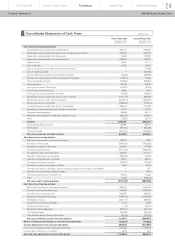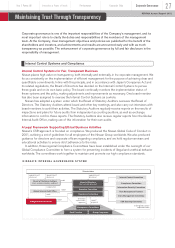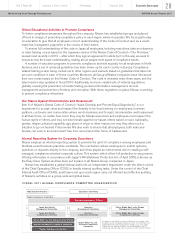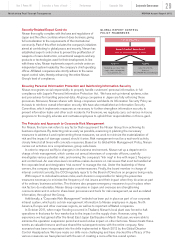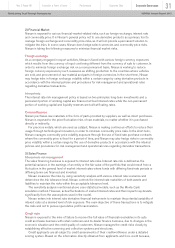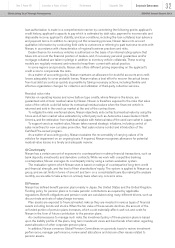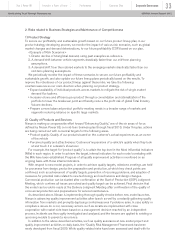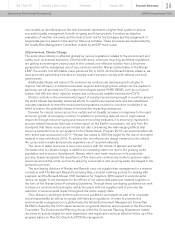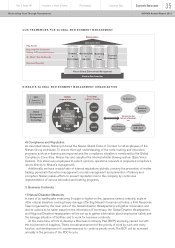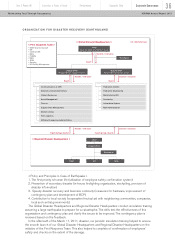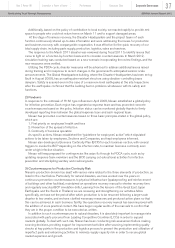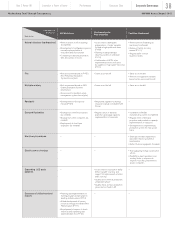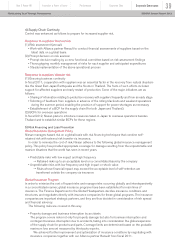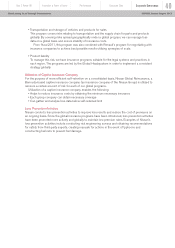Nissan 2012 Annual Report Download - page 35
Download and view the complete annual report
Please find page 35 of the 2012 Nissan annual report below. You can navigate through the pages in the report by either clicking on the pages listed below, or by using the keyword search tool below to find specific information within the annual report.
new models, as described above, the new framework represents a higher-level system to ensure
successful quality management for both on-going and future projects. It involves an objective
evaluation of whether risk exists and the level of such risk for the Company and the assignment of
responsible persons based on the level for follow-up activities. These processes are implemented by
the Quality Risk Management Committee, chaired by an EVP twice a year.
3) Environment, Climate Change
The automotive industry is affected globally by various regulations related to the environment and
safety, such as exhaust emissions, CO2/fuel efficiency, noise and recycling, and these regulations
are getting more stringent year by year. In this context, one effective solution from a long-term
perspective will be widespread use of zero-emission vehicles. Nissan started sales of the Nissan
LEAF, the world’s first affordable, mass-produced EV, in 2010. As the Renault-Nissan Alliance, we
have promoted partnership formation to develop a zero-emission society with national and local
governments.
Additionally, Nissan will reduce CO2 emissions by continuously developing technologies to
improve fuel efficiency in internal combustion engines and bringing them widely into the market. In
particular, we will promote low CO2 output technologies named PURE DRIVE, such as our hybrid
system, fuel efficient direct injection engine and continuously variable transmission (CVT).
Stricter controls on the environmental impact of substances are being sought in countries around
the world. Nissan has steadily advanced efforts to meet these requirements and has established
voluntary standards to meet the environmental regulations enacted in countries worldwide in an
effort to reduce the potential release of environment-impacting substances.
Demand for natural resources such as metals and oil steadily increases in response to the rapid
economic growth of emerging countries. In addition to promoting reduced use of virgin natural
resources through resource-saving and resource-recycling measures, it is becoming important to
procure natural resources that have a lower impact on the Earth’s ecosystems, not only from the
standpoint that these resources are limited, but also considering the wide-ranging effects that
resource extraction has on ecosystems. In the Nissan Green Program 2016—an environmental mid-
term action plan announced in 2011—Nissan has raised to 25% the target for the use of recovered
material in new vehicles by 2016. To achieve this, we will promote design centered on the vehicle
life cycle, reduce waste and promote expanded use of recycled materials.
The issue of water resources is ever more serious with the retreat of glaciers and rainfall
fluctuation due to climate change, in addition to increasing water use due to the growing world
population and economic development. Nissan, which uses water resources in its production
process, deeply recognizes the importance of this issue and continuously works to preserve water
resources around the world, such as by reducing consumption and recycling water discharged in the
production process.
The purchasing divisions of Nissan and Renault carry out supply-chain management in a manner
consistent with The Renault-Nissan Purchasing Way, a booklet outlining policies for dealing with
suppliers, and the Renault-Nissan CSR Guidelines for Suppliers. With respect to environmental
issues, we began to set standards for the efforts of our automobile parts and material suppliers in
the form of the Nissan Green Purchasing Guidelines. Through these purchasing guidelines we seek
to share our environmental principles and action plans with our suppliers and to promote the
reduction of environmental impact throughout the entire supply chain.
Thus, Nissan is working to achieve autonomous guidelines and targets as part of its corporate
social responsibility as well as to comply with laws and regulations. In order to promote this
environmental management on a global basis, the Global Environment Management Committee
(G-EMC) chaired by the COO makes decisions on general direction and proposals to the Executive
Committee. The Environmental Planning Group within the Corporate Planning Department makes
decisions on activity targets for each department and region and conducts effective follow up of the
progress based on Plan-Do-Check-Act (PDCA) management.
Innovation & Power of brandYear 2 Power 88 Performance Corporate Data
Corporate Governance 34
NISSAN Annual Report 2012Maintaining Trust Through Transparency


